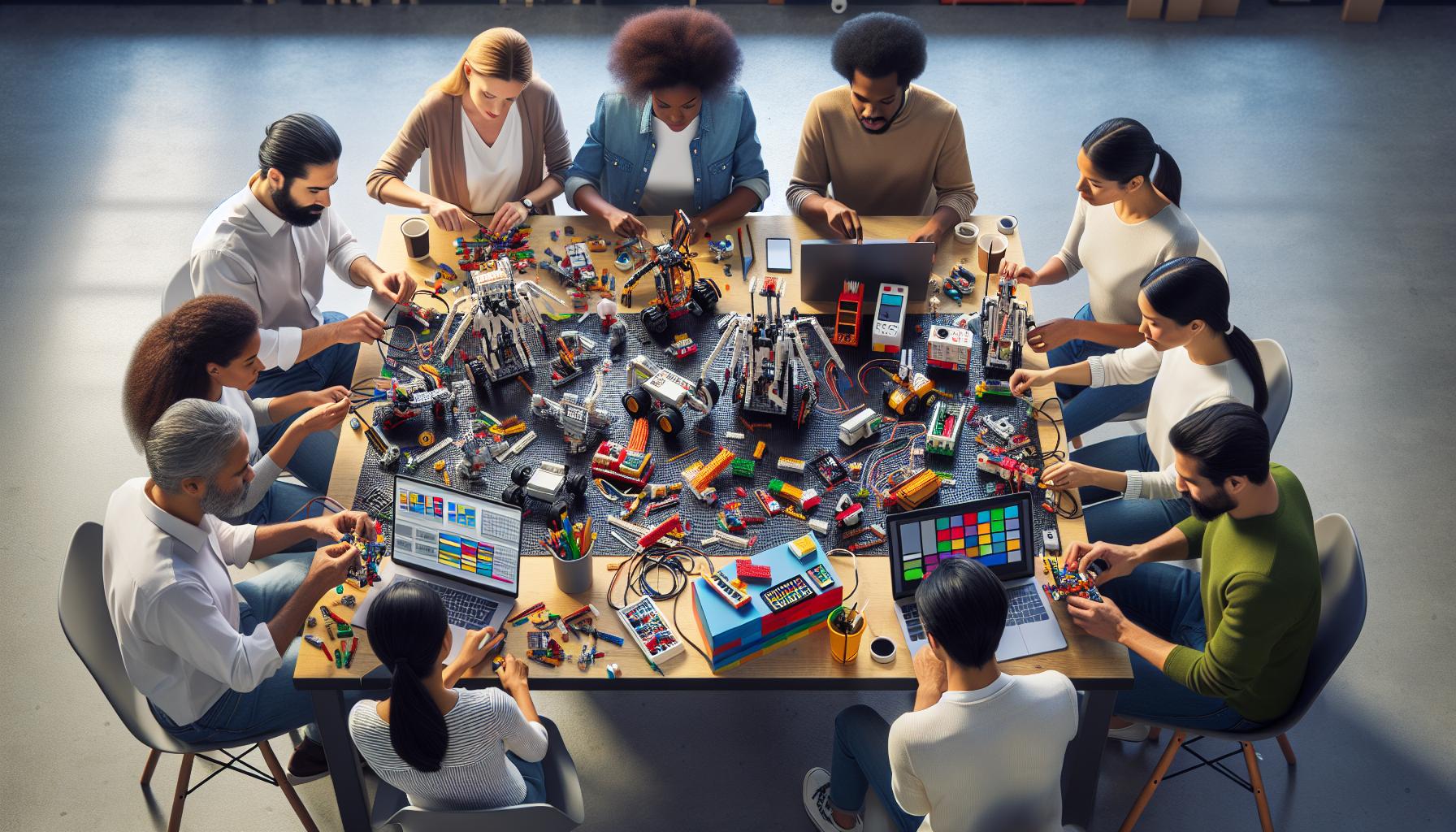Key Takeaways
- Innovative Creations: Lego gadgets combine traditional building with modern technology, offering endless possibilities for creativity and functionality.
- Educational Benefits: Engaging with Lego gadgets promotes STEM learning, teaching concepts in programming, mechanics, and problem-solving through hands-on experiences.
- Diverse Types: Popular categories such as motorized creations and remote-controlled models highlight the versatility of Lego gadgets, appealing to builders of all ages.
- Essential Building Techniques: A variety of tools, materials, and collaborative approaches can enhance the building process, leading to more innovative and functional designs.
- Skill Development: Working on Lego gadgets helps cultivate critical thinking, teamwork, and resilience, valuable skills applicable in various domains.
In a world where creativity meets technology, Lego gadgets are capturing the imagination of builders everywhere. These innovative creations blend the timeless joy of Lego with modern functionality, transforming simple bricks into impressive devices. From automated machines to interactive games, the possibilities are endless.
Lego gadgets not only entertain but also educate, encouraging problem-solving and engineering skills in builders of all ages. Whether it’s a programmable robot or a mini drone, these projects inspire a sense of accomplishment and ignite a passion for invention. As more enthusiasts dive into the world of Lego engineering, the trend of creating gadgets from these iconic bricks continues to grow, making it an exciting time for both seasoned builders and newcomers alike.
Lego Gadgets
Lego gadgets merge traditional building with contemporary technology, allowing enthusiasts to create functional devices. These gadgets range from simple machines to complex robotics that illustrate principles of engineering and programming.
Lego Mindstorms provides tools for building programmable robots, enabling users to experiment with coding and robotics. Builders can create models that perform specific tasks, enhancing critical thinking and creativity.
Additionally, Lego’s Technic series features intricate models with moving parts, gears, and pulleys. These models demonstrate advanced mechanical concepts and provide insight into real-world mechanisms.
Lego-compatible electronics, such as motors and sensors, further expand the possibilities. These components allow for the design of interactive gadgets that respond to environmental stimuli. Integrating these elements encourages exploration of engineering principles and electronics.
Lego gadgets stimulate imagination, making them popular among children and adults alike. They encourage collaborative learning experiences, fostering teamwork and communication skills while building innovative creations.
Popular Types of Lego Gadgets

Lego gadgets encompass various categories, each showcasing unique functionalities that appeal to creators. Below are popular types of Lego gadgets that builders frequently explore.
Motorized Creations
Motorized creations involve the integration of Lego components with motors, enabling movement and automation. These gadgets include vehicles like cars and trains that can navigate tracks or drive on surfaces. Examples include Lego Technic models, which often feature gears and pulleys to power moving parts. Motorized robots capable of performing tasks, such as picking up objects or navigating obstacles, emphasize engineering principles. Additionally, models like Lego Ferris wheels showcase intricate designs along with mechanical motion, illustrating the blend of creativity and technical skills.
Remote-Controlled Models
Remote-controlled models allow users to operate their Lego builds from a distance using controllers or apps. These devices often combine Lego bricks with remote-control technology, enabling live manipulation. Examples include Lego cars that race across floors or hovercrafts that glide smoothly on water. Builders frequently use Lego Mindstorms for programming and controlling robots via Bluetooth, enhancing the interactive experience. The combination of building with electronics facilitates a deeper understanding of how remote-controlled machines function, making these models popular among enthusiasts.
Building Techniques for Lego Gadgets

Building Lego gadgets requires specific tools and materials to enhance creativity and functionality. Understanding these elements can inspire builders to elevate their projects.
Essential Tools and Materials
- Lego Bricks: Use a variety of standard and specialized bricks, including Technic pieces, to create functional structures.
- Motors: Incorporate motors to enable movement in gadgets, essential for projects like robotic arms or motorized vehicles.
- Sensors: Utilize sensors such as motion or touch sensors to add interactivity; this allows gadgets to respond to their environment.
- Wires and Connectors: Gather wires and connectors for linking electronic components, ensuring clear connections between parts.
- Lego Mindstorms Kits: Leverage Mindstorms kits, which come with programmable bricks, motors, and sensors; these kits simplify coding and robotic building.
- Workspace: Set up an organized workspace with ample lighting and storage; this encourages efficient building and easy access to components.
- Experiment: Test different combinations of bricks and components to discover unique designs and functions.
- Prototype: Build prototypes to visualize concepts; this iterative process enhances problem-solving and technical understanding.
- Collaborate: Work with others on projects; teamwork brings diverse ideas and solutions, improving the building experience.
- Document Ideas: Keep a notebook or digital file for sketches and notes; this practice captures inspiration for future builds.
- Utilize Online Resources: Access tutorials and forums for guidance; online communities offer troubleshooting and innovative techniques shared by experienced builders.
- Play and Tinker: Allow time for playful exploration of ideas; this leads to spontaneous creativity and unexpected functionality.
Benefits of Lego Gadgets

Lego gadgets offer numerous benefits that span educational, cognitive, and social domains. These advantages contribute significantly to the development of skills that are valuable in various aspects of life.
Educational Value
Lego gadgets provide significant educational value, engaging builders in STEM (science, technology, engineering, and mathematics) learning. They introduce concepts such as physics, mechanics, and coding within a hands-on environment. Projects using Lego Mindstorms foster understanding of programming logic while developing troubleshooting skills. Additionally, Lego construction promotes spatial awareness and design thinking, skills essential for careers in engineering and architecture. These gadgets facilitate learning through play, making complex concepts accessible and enjoyable.
Enhancing Problem-Solving Skills
Lego gadgets enhance problem-solving skills by challenging builders to navigate obstacles during the creation process. Builders face design challenges that require critical thinking, iteration, and reflection. For instance, when a robot fails to complete a task, it prompts the user to analyze its behavior and make adjustments to the code or mechanics. This iterative approach cultivates resilience and adaptability, key attributes in effective problem-solving. Collaborating with others further enhances these skills as builders share insights and devise collective solutions.
Blend of Creativity And Technology
Lego gadgets represent a fascinating blend of creativity and technology that captivates builders of all ages. They not only entertain but also serve as powerful educational tools that nurture essential skills like problem-solving and critical thinking. As enthusiasts continue to innovate and explore, the potential for new and exciting creations seems limitless.
The journey of building Lego gadgets encourages collaboration and experimentation, fostering a community of creators eager to share their discoveries. Embracing this trend opens doors to a world where imagination meets engineering, making the experience both enriching and enjoyable. Whether for fun or learning, Lego gadgets truly inspire the next generation of inventors and engineers.

